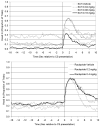Dopamine D1 and D2 antagonist effects on response likelihood and duration
- PMID: 20001111
- PMCID: PMC2821424
- DOI: 10.1037/a0017702
Dopamine D1 and D2 antagonist effects on response likelihood and duration
Abstract
Experimentally induced and parkinsonian disruptions in dopamine (DA) transmission are associated with motor abnormalities that include a reduced likelihood of behavioral response initiation and an increased duration of executed responses. Here we investigated the dopamine receptor subtypes involved in regulating these two aspects of behavior. We examined the effects of D1 family (D1/D5) antagonist R(+)-7-chloro-8-hydroxy-3-methyl-1-phenyl-2,3,4,5-tetrahydro-1H-3-benzazepine hydrochloride (SCH23390; 0, 0.04, 0.08, or 0.16 mg/kg) and D2/D3 antagonist 3,5-dichloro-N-(1-ethylpyrrolidin-2-ylmethyl)-2-hydroxy-6-methoxybenzamide (+)-tartrate salt (raclopride; 0, 0.2, or 0.4 mg/kg) on the likelihood and duration of a cued Pavlovian approach and a cued operant lever-press response. While the high doses of the D1 and D2 antagonists produced similar levels of overall locomotor suppression, only the D2 antagonist increased the duration of time that animals' heads remained in the food compartment during both Pavlovian and operant task performance. In contrast, D1 antagonist SCH23390 decreased the proportion of trials in which animals executed both the Pavlovian approach and operant lever-press, while raclopride did not. The results suggest that D2 receptor blockade preferentially increases response duration, and, under the simple discrete-trial procedures employed here, D1 receptor blockade preferential reduces Pavlovian and operant response likelihood.
Figures





References
-
- Alexander GE, Crutcher MD. Functional architecture of basal ganglia circuits: neural substrates of parallel processing. Trends Neurosci. 1990;13(7):266–271. - PubMed
-
- Amalric M, Berhow M, Polis I, Koob GF. Selective Effects of Low-Dose D2-Dopamine Receptor Antagonism in A Reaction-Time-Task in Rats. Neuropsychopharmacology. 1993;8(3):195–200. - PubMed
-
- Baik JH, Picetti R, Saiardi A, Thiriet G, Dierich A, Depaulis A, Le Meur M, Borrelli E. Parkinsonian-like locomotor impairment in mice lacking dopamine D2 receptors. Nature. 1995;377(6548):424–428. - PubMed
-
- Baldo BA, Sadeghian K, Basso AM, Kelley AE. Effects of selective dopamine D1 or D2 receptor blockade within nucleus accumbens subregions on ingestive behavior and associated motor activity. Behav Brain Res. 2002;137(1-2):165–177. - PubMed
-
- Beninger RJ, Miller R. Dopamine D1-like receptors and reward-related incentive learning. Neurosci Biobehav Rev. 1998;22(2):335–345. - PubMed

